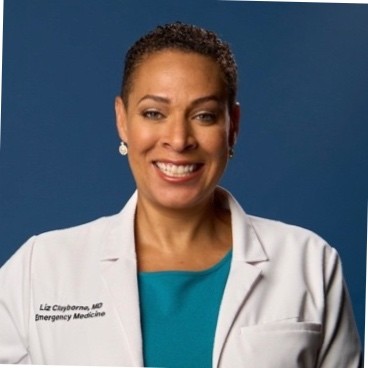- Video Library
- Elizabeth Clayborne, NasaClip - Adjustable Nosebleed Rescue Device | LSI USA '24
Elizabeth Clayborne, NasaClip - Adjustable Nosebleed Rescue Device | LSI USA '24

Elizabeth Clayborne
Dr. Elizabeth Clayborne was born and raised in Denver, Colorado. She attended Duke University as an undergraduate where she designed her own major in Medical Ethics and Religion. Prior to medical school she completed a two-year research fellowship at National Institutes of Health in the Social and Behavioral Research Branch of the National Human Genome Research Institute with a research focus on race, ethnicity and genetics. Dr. Clayborne attended medical school at Case Western Reserve University where she completed a dual MD/MA Bioethics degree in 4 years. She went on to complete residency in Emergency Medicine at the George Washington University Hospital and served as Chief Resident in her fourth year.
Dr. Clayborne is currently a faculty member at the University of Maryland School of Medicine Department of Emergency Medicine with an academic focus on ethics, health policy, end of life care and innovation/entrepreneurship.
She developed a novel nosebleed device, NasaClip, as a resident and in 2015 was awarded the NSF I-Corps grant which helped to launch her company NasaClip. She has raised over $3M in funding and was awarded a NSF SBIR Phase I grant for $256K of non-dilutive funds. Her company launched the Class I version of her device into the market in late 2023.
Elizabeth Clayborne
Dr. Elizabeth Clayborne was born and raised in Denver, Colorado. She attended Duke University as an undergraduate where she designed her own major in Medical Ethics and Religion. Prior to medical school she completed a two-year research fellowship at National Institutes of Health in the Social and Behavioral Research Branch of the National Human Genome Research Institute with a research focus on race, ethnicity and genetics. Dr. Clayborne attended medical school at Case Western Reserve University where she completed a dual MD/MA Bioethics degree in 4 years. She went on to complete residency in Emergency Medicine at the George Washington University Hospital and served as Chief Resident in her fourth year.
Dr. Clayborne is currently a faculty member at the University of Maryland School of Medicine Department of Emergency Medicine with an academic focus on ethics, health policy, end of life care and innovation/entrepreneurship.
She developed a novel nosebleed device, NasaClip, as a resident and in 2015 was awarded the NSF I-Corps grant which helped to launch her company NasaClip. She has raised over $3M in funding and was awarded a NSF SBIR Phase I grant for $256K of non-dilutive funds. Her company launched the Class I version of her device into the market in late 2023.

17011 Beach Blvd, Suite 500 Huntington Beach, CA 92647
714-847-3540© 2025 Life Science Intelligence, Inc., All Rights Reserved. | Privacy Policy







